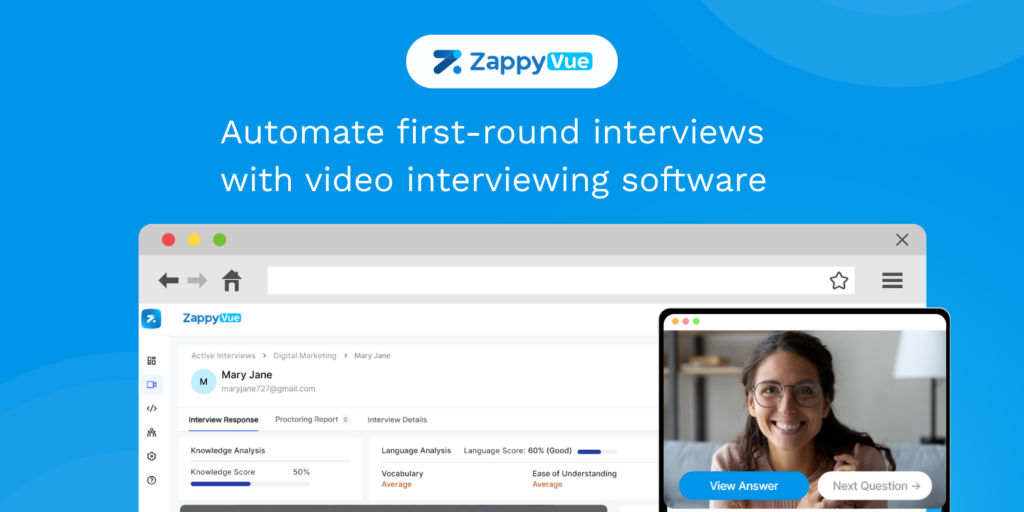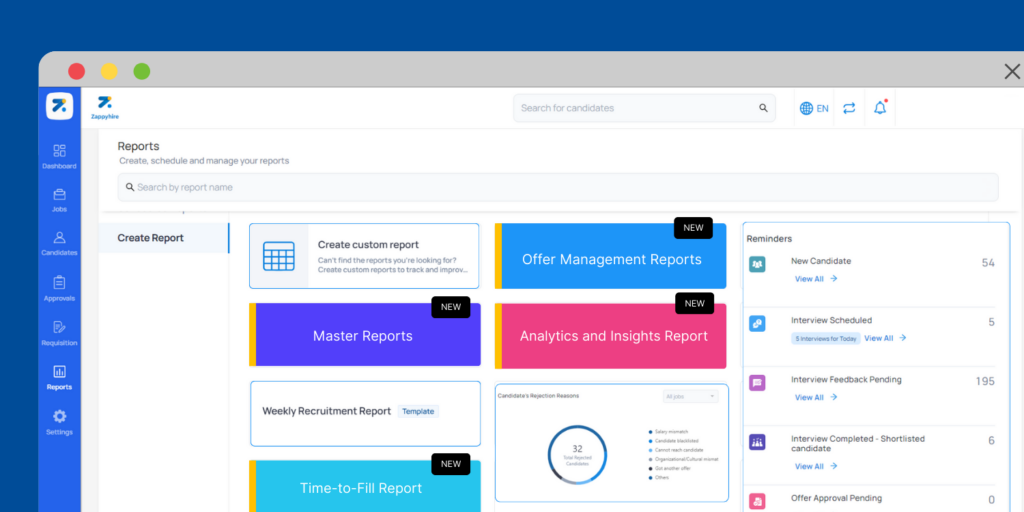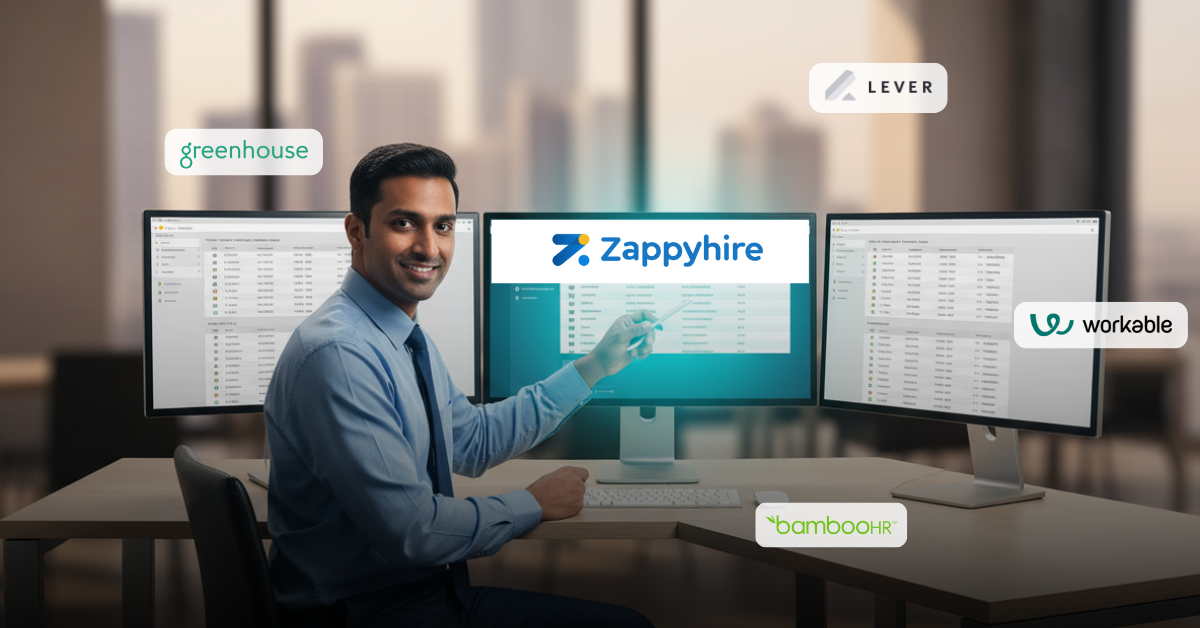
Modern hiring can feel like a never-ending to-do list. That’s why more and more companies are turning to hiring automation to speed things up, cut down costs, and make better hiring decisions.
Given that recruiters spend up to 30 hours a week on admin-heavy tasks, it’s no wonder 85% of employers who’ve embraced automation in recruitment say it’s a boon for efficiency.
Here’s what the Co-founder of Zappyhire, an AI-powered recruitment automation platform, Jyothis K S has to say about automating the recruitment process.
“There are multiple stages or touch points in the spectrum of recruitment where we can integrate AI. We’ve identified around 16+ recruitment use cases where automation can be an enabler, not a decision-maker.” (paraphrased)
So, let’s get into 13 strategies of how you can automate your hiring process – from tools to workflow tweaks – that’ll help simplify the way you recruit.
1. Automated job requisition & posting
The hiring journey begins with a need – a hiring manager requests to fill a role. Automating the job requisition approval workflow can significantly speed up this initial step.
Instead of chasing email approvals, an Applicant Tracking System (ATS) can route requisitions to the right managers for one-click approvals, ensuring new positions are green-lit faster.
Once a job is approved, automated job posting tools can publish the vacancy across multiple job boards and social media platforms simultaneously.
2. AI-powered candidate sourcing
Finding great talent isn’t limited to incoming applications, as a great fit could be a passive candidate.
Automating candidate sourcing can proactively identify potential candidates – even those who haven’t applied yet – by scanning resumes databases, professional networks, and social media for relevant profiles.
AI-driven sourcing tools (sometimes called talent intelligence platforms) can parse through millions of online profiles to find matches based on the job requirements, then automatically reach out with personalized messages.
3. Pre-Screening with AI-powered Video Interviews
As applications roll in, the first filter in a high-volume hiring process is often a simple yes/no qualifier.
High-volume hiring demands speed without compromising quality – and that’s exactly what automated video interviews deliver. Instead of scheduling dozens of initial calls, recruiters can set up a consistent set of questions (e.g., “Tell us about a successful project” or “Are you open to learning new tools?”) in a one-way video interview platform.

Candidates record responses on their own time, and hiring teams review them later – eliminating scheduling conflicts and allowing faster, fairer screening at scale.
Advanced platforms go a step further with AI-powered analysis. The system evaluates video responses for communication skills, domain knowledge, and even personality traits by analyzing speech patterns and word choices. It then generates interview scores and insights to support data-driven shortlisting.
4. Resume parsing and screening with AI
Reviewing resumes is traditionally one of the most labor-intensive parts of hiring.
Recruiters simply don’t have hours to read each resume in depth (one study found they spend only about 7.4 seconds scanning a resume on average).
This is where AI-powered resume parsing and screening shines.
Sangeeta Singh, Director of Talent Acquisition at Shaadi.com said,
“Sorting through the resumes that don’t meet the basic qualifications can lead to a lot of time wastage. This can be mitigated through better job targeting, AI-powered resume screening, and clearly defining the role requirements.” (paraphrased)
A resume parser automatically reads and extracts key information from resumes – like education, skills, years of experience, past job titles – and converts unstructured resumes into a structured database format.
This upfront automation means the system can instantly flag top candidates who meet your criteria and screen out those who don’t, without a recruiter lifting a finger.
Bonus – It also makes the screening process more consistent and fair – the AI applies the same criteria to every applicant, helping to remove human bias from the initial selection.
5. Intelligent candidate matching and shortlisting
Beyond basic screening, advanced systems use algorithms to match candidates to the job requirements and even rank them by fit.
This goes a step further in automation. Rather than just eliminating mismatches, the system actively identifies which applicants are the most promising.
The result is an automatically curated shortlist of top candidates for recruiters to focus on first. This kind of recruitment automation process ensures the best talent doesn’t get lost in the pile.
This makes it a prime example of automation in the recruitment process adding value – the tech does the heavy analysis, while humans make the final judgment calls from a refined list.
6. Chatbot engagement and candidate FAQs
First impressions matter, and candidates often have questions the moment they consider applying. AI-powered recruitment chatbots on your careers site or messaging platforms can automate candidate engagement by answering FAQs and even conducting initial screenings via conversation.
These conversational AI bots are available 24/7 to handle inquiries like “What is your remote work policy?” or “What’s the next step after I apply?”, giving candidates instant responses and guidance.
This kind of hiring automation not only improves the candidate experience (no more waiting days for an email reply), but also saves your recruiting team countless hours.
Jyothis K S stated in a webinar,
“When it comes to the speed of the hiring, normally two types of delays come in – one is process delay, second is coordination delay. In both cases, using proper AI use cases, these two delays can be largely avoided.” (paraphrased)
7. Candidate evaluation with automated skill assessments
Once you have a pool of qualified applicants, the next step in many hiring processes is to evaluate specific skills or aptitudes. Manually administering tests or scheduling assessments can be a logistical headache.
Instead, companies can automate candidate assessments by integrating them into their recruitment workflow.
For example, when a candidate passes initial screening, the system can automatically send them a link to an online skills test or psychometric assessment.
There are platforms that offer coding challenges for software developers, situational judgment tests for managers, language proficiency tests, and more – all of which can be completed by candidates remotely at their convenience.
The testing platform then automatically scores the results and feeds them back into your ATS.
8. Streamlined interview scheduling
Scheduling interviews is often a recruiter’s biggest headache – juggling calendars, sending emails back and forth, and finding slots that work for everyone. In fact, surveys indicate that recruiters spend about 35% of their time on scheduling logistics alone.
That’s a huge chunk of time that can be reclaimed through automation. Automated interview scheduling tools integrate with your team’s calendars (e.g., Outlook or Google Calendar) and allow candidates to self-schedule their interviews based on available time slots.
Here’s how it typically works. Once a candidate reaches the interview stage, the system sends them a link to a scheduling portal.
The candidate can pick from pre-set available slots (which the system knows by checking interviewers’ synced calendars) and book their preferred time.
Both the candidate and interviewers then get an automatic confirmation and calendar invite.
9. Automated interview feedback & workflow management
Within large enterprises, collaborative hiring often takes place. Meaning, the hiring process isn’t just between recruiter and candidate – it involves coordination with hiring managers, interview panelists, and HR approvals.
Automating those internal recruitment workflows can eliminate bottlenecks that slow down decisions.
For example, after an interview, the system can automatically send a feedback form or evaluation rubric via email to the interviewer, prompting them to submit their feedback by a certain deadline.
This helps replace the recruiter’s manual task of chasing down managers for input.
Similarly, automation can streamline approval steps, like getting the green light to extend an offer.
Instead of a chain of emails, an ATS can route a digital offer approval to the department head and HR, complete with all candidate info and proposed salary, and collect e-signatures or approvals in one place.
Hence, you ensure momentum is never lost and everyone involved knows what to do when, without constant manual check-ins.
10. Reference and background checks automation
Manual reference and background checks can be slow and tedious; for example, chasing former supervisors or waiting on verification reports. Automation simplifies this.
With automated reference checks, candidates enter referees’ email IDs, and the system sends out standardized questionnaires. Responses come in confidentially and are compiled into structured, comparable reports – no more phone tag.
Similarly, background check integrations can auto-submit candidate data (with consent) to third-party services for criminal, education, and employment checks. Recruiters get real-time status updates without lifting a finger.
This not only saves time but ensures no step is skipped – essential when hiring at scale.
11. Auto-generated offer letters and contracts
You’ve found the ideal candidate – now it’s time to officially bring them on board. Drafting offer letters or contracts for each new hire can be repetitive and prone to errors if done manually.
When you automate offer letter generation and management,, you can create templates for offer letters that automatically pull in the candidate’s details (name, position, salary, start date, etc.) and generate a ready-to-send digital offer in seconds.
Instead of editing Word documents for each offer, the recruiter can just verify the auto-filled details and hit send.
This ensures consistency (every candidate gets the correct, approved wording) and cuts down administrative work.
Many ATS platforms include an offer letter automation feature, often integrated with e-signature functionality.
For example, the system can email the candidate a personalized link to their secure offer letter; the candidate can electronically sign the document, and the platform will notify the recruiter once it’s signed.
12. Onboarding automation
The hiring process doesn’t end when the offer is accepted. A smooth transition from candidate to employee is critical – and much of onboarding can be automated to ensure new hires feel welcome and equipped from Day 1.
Onboarding automation typically includes sending electronic welcome packets, handling paperwork digitally, and setting up necessary accounts or equipment through workflow triggers.
For example, as soon as a candidate signs the offer, the system can automatically send them an onboarding portal link where they can fill out HR forms (tax forms, direct deposit info, NDA, etc.) electronically, rather than dealing with tedious physical paperwork on their first day.
You can also automate the provisioning process: the system notifies IT to create the new employee’s email and accounts, requests Security to prepare an access badge, and so on – all through preset workflows.
This is especially valuable in large organizations where multiple departments need to act when a new hire comes on board. Automating those notifications and tasks ensures nothing falls through the cracks.
13. Recruitment analytics and continuous improvement
Embracing recruitment analytics and reporting ensures your investment in automation pays off by highlighting efficiencies and areas of opportunity.
By capturing every step of the hiring process digitally, an advanced recruitment automation platform can automatically generate reports on key metrics – time-to-hire, cost-per-hire, source of hire, quality of hire, and more, without manual data crunching.

Instead of pulling data ad-hoc (e.g., spending hours collating spreadsheets quarterly), recruiters can have the progress and performance of their recruitment efforts readily available to share with their seniors..
This kind of automated recruitment metrics reporting also creates a continuous feedback loop for improving your hiring process.
Embrace hiring automation to modernize recruitment
From the first job posting to the final onboarding steps, these 13 automation techniques illustrate how every stage of the hiring journey can be optimized.
For HR leaders and recruiters in enterprise organizations, the message is clearer than ever that it’s time to modernize your hiring using technology.
As Jyothis K S aptly put it,
“The future of recruitment isn’t about AI replacing humans – it’s about empowering them with better tools to make informed decisions.” (paraphrased)
Now is the time to take action. Evaluate your current hiring stages, identify the low-hanging fruit for automation, and start with a pilot. Small wins will build confidence and momentum.
In the race for talent, those who embrace hiring automation will undoubtedly lead the pack. It’s time to join them and transform your recruitment journey for the better.






